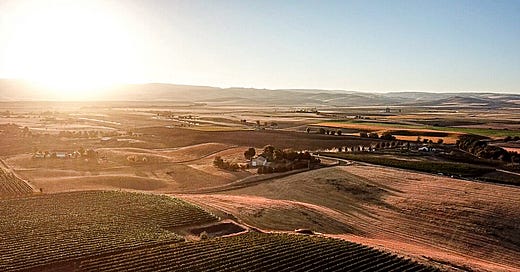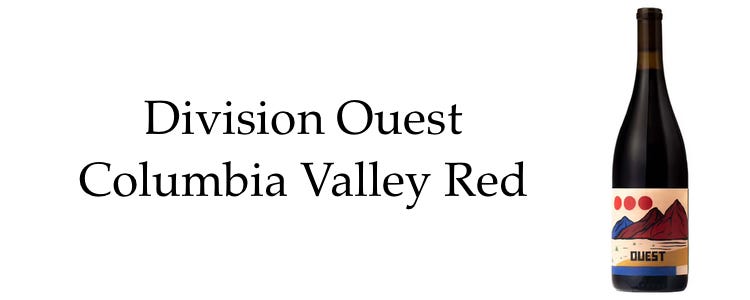A tasty, unexpected red blend
Some flavors naturally go together: Salt and pepper, toast and jelly, coffee and chocolate, and the grape blends in Chianti, Bordeaux or the Southern Rhône.
The idea of mixing and matching compatible flavors makes sense: By combining two things that work together, we hope to gain a combination that’s more than the sum of its parts. Of course this is a matter of taste: Pickles and pretzels, all right! Pickles and ice cream, not so much.
But we’re here today to think about wine, and in that realm we’re guided by a great deal of tradition. …
What do you think of varietal blends that don’t traditionally go together?
Tell us about your experiences in Substack Chat!!
Chianti, for instance, enjoys a history in central Tuscany that goes back to the 1300s; its Sangiovese-forward but multigrape formula has been closely regulated, although with some modern tweaks, for well over a century.
Around Europe and everywhere else in the world where wine has traveled, tradition is very much a part of the process, and it’s a tradition based on experiment and experience aimed at figuring out what tastes good. That’s how Chianti evolved, and we find parallel stories in Bordeaux, where tradition requires red blends of Cabernet Sauvignon, Merlot, Cabernet Franc and a few minor companions; or in the Southern Rhône Valley, where Grenache, Syrah, Mourvèdre and another 10 less-familiar choices mix and match in the reds.
In many other areas, though, single-varietal wines, made entirely without intrusion by other grapes, are well established by tradition and by law. Burgundy, for instance, is strictly Pinot Noir for reds, and Chardonnay for whites. In northwestern Italy, Piemontese reds like Barolo and Barbaresco are made entirely of Nebbiolo. And so it goes, by law or by custom, as in Napa Valley, where 100% Cabernet Sauvignon has been enshrined by the demands of the trophy-wine market.
All of this is pretty much basic Wine 101. But thanks to the power of tradition, exceptions to the rule aren’t much more common than bananas with cream cheese or orange juice with Oreos. We know what works, and unconventional ideas instinctively sound wrong. A blend of Cabernet Sauvignon and Pinot Noir? I might try it, but I wouldn’t expect to love it. Ditto for a Zinfandel-and-Merlot blend.
Vineyard scene in the arid Columbia Valley, where 99% of Washington State’s 11 million acres of wine grapes grow. (Image from WashingtonWine.org.)
But now and then an offbeat blend pops up that, contrary to reasonable expectation, actually works. So it is with today’s featured wine, a well-structured but easy drinking red from Washington State’s Columbia Valley that brings together an offbeat Italian-French blend of 50% Sangiovese, 25% Nebbiolo, and 25% Syrah.
Those geographically disparate grapes from Tuscany, Piemonte, and the Southern Rhône might not seem to go together, but as I mentally taste them in memory they don’t actually clash. And sure enough, organically and sustainably grown Division Ouest Columbia Valley Red makes an amiable, easy-drinking, well structured wine that justifies its price point in the upper teens into the twenties.
My tasting report follows. Meanwhile, if you’d like to learn more about the huge Columbia Valley American Viticultural Area, which takes up a large chunk of arid central Washington and extends over into a bit of northern Oregon, here’s a good overview from WashingtonWine.org. Wine-Searcher.com also has a good Columbia Valley article at this link.
Today’s Tasting Report
Division 2022 Ouest Columbia Valley Red Wine ($17.99)
An offbeat but persuasive blend of Sangiovese, Nebbiolo, and Syrah, Division Ouest Columbia Valley Red is made with organic and sustainably farmed grapes, organic yeast nutrient, and limited sulfiting. It’s a dark reddish-purple color shading to a clear garnet edge, and breathes appealing scents that testify to its mixed varietal sources: Ripe cherries, mixed red berries, and – coming across more clearly in its flavor – freshly ground black pepper and subtle smoke and leather. Fresh-fruit acidity makes it food-friendly, and a hint of tannic astringency adds structure that becomes more evident in the long finish. There’s a hint of warmth, but 13.5% alcohol is well within reasonable limits. (Sept. 19, 2024)
FOOD MATCH: The producer describes this as a pizza-party wine, which hints at a style more suited to casual events than formal dining. Pizza and pasta, burgers, modern plant-based burgers, chile con or sin carne and similar hearty fare would suit it well.
WHEN TO DRINK: It’s hard to predict cellaring hopes for unusual varietal blends, but while this young wine is fun and easy now, I don’t see it as a candidate for extended cellaring.
VALUE:
I grabbed this wine locally for $18, which proved a good bargain considering the wine’s $22 price at the winery and Wine-Searcher.com’s $22 average U.S. retail
WEB LINK:
Here’s the producer’s Ouest fact sheet and ordering page.
FIND THIS WINE ONLINE:
Check prices and find vendors for Division Ouest Columbia Valley Red on Wine-Searcher.com.
Discover Washington State’s Columbia Valley and its wines at this Wine-Searcher link.
This Wine-Searcher link features the Division Wine Co. portfolio of wines, with retail prices and links to buy.
Find the wines you want
Explore Wine-Searcher
Wine-Searcher.com is the place to go online if you want to find where to buy a particular wine that interests you. What’s more, Wine-Searcher.com offers so much more. It’s well worth a visit just to discover its many features, including its popular list of the world’s Top 10 Best Value Wines.
Good wines we’ve tried under $10.99!
Want tips to still more good, inexpensive wines? Here are Wine-Searcher links to vendors and prices for a bunch more wines for $10.99 or less that I’ve told you about in recent years. In some cases the prices may have risen over the $10.99 mark since I reviewed them, but they should still be excellent bargains. Please tell us about your favorites!
Sponsor the Wine Advisor.
Support The 30 Second Wine Advisor and help us pay the rent while reaching 25,000 dedicated readers with your sponsorship message in this space, at the top of this E-letter, and on our social media. If you’re an established business in wine, food, and similar ventures, there’s no better way to focus your message toward an audience that comes here for just those topics. See our Sponsorship Page, or email Robin Garr for more information.
Wine Forum and Social Media
You’re always welcome to drop by our WineLovers Discussion Group, the Internet’s first and most civil online community. Discussions are open for public viewing, but you must register to post. To request registration, please contact me at wine@wineloverspage.com, tell me your name, mention the Wine Advisor, and briefly say why you’d like to participate in the forum. Sorry about the minor red tape, but this is our simple, low-tech way to deter spammers and bots.
I’d also be delighted to have you visit and “like” our WineLovers Facebook Page.
Read more articles from The 30 Second Wine Advisor
Previous Issue: « Sauvignon Blanc: Love it or hate it?






